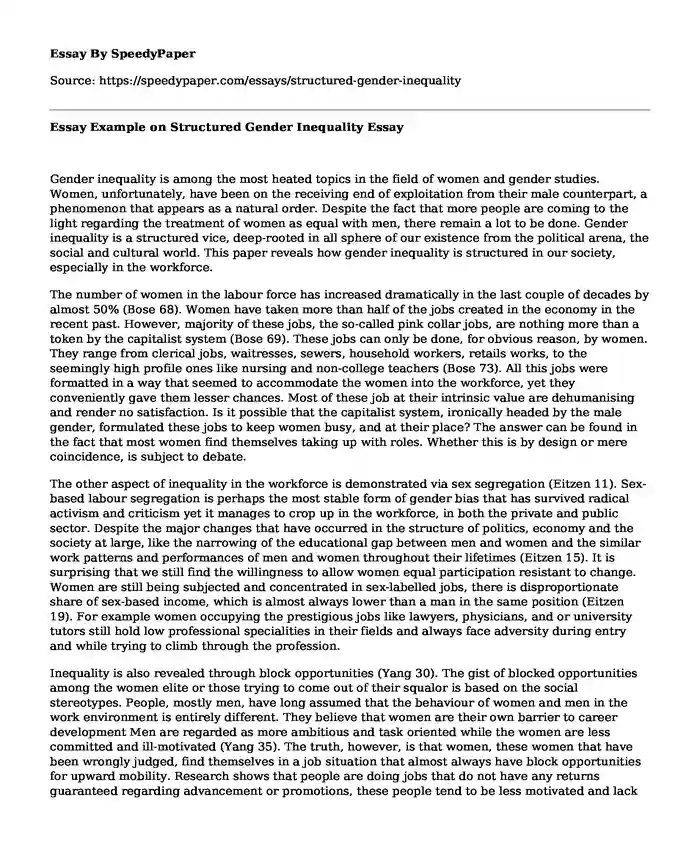
| Type of paper: | Essay |
| Categories: | Gender Discrimination Feminism Social justice |
| Pages: | 3 |
| Wordcount: | 758 words |
Gender inequality is among the most heated topics in the field of women and gender studies. Women, unfortunately, have been on the receiving end of exploitation from their male counterpart, a phenomenon that appears as a natural order. Despite the fact that more people are coming to the light regarding the treatment of women as equal with men, there remain a lot to be done. Gender inequality is a structured vice, deep-rooted in all sphere of our existence from the political arena, the social and cultural world. This paper reveals how gender inequality is structured in our society, especially in the workforce.
The number of women in the labour force has increased dramatically in the last couple of decades by almost 50% (Bose 68). Women have taken more than half of the jobs created in the economy in the recent past. However, majority of these jobs, the so-called pink collar jobs, are nothing more than a token by the capitalist system (Bose 69). These jobs can only be done, for obvious reason, by women. They range from clerical jobs, waitresses, sewers, household workers, retails works, to the seemingly high profile ones like nursing and non-college teachers (Bose 73). All this jobs were formatted in a way that seemed to accommodate the women into the workforce, yet they conveniently gave them lesser chances. Most of these job at their intrinsic value are dehumanising and render no satisfaction. Is it possible that the capitalist system, ironically headed by the male gender, formulated these jobs to keep women busy, and at their place? The answer can be found in the fact that most women find themselves taking up with roles. Whether this is by design or mere coincidence, is subject to debate.
The other aspect of inequality in the workforce is demonstrated via sex segregation (Eitzen 11). Sex-based labour segregation is perhaps the most stable form of gender bias that has survived radical activism and criticism yet it manages to crop up in the workforce, in both the private and public sector. Despite the major changes that have occurred in the structure of politics, economy and the society at large, like the narrowing of the educational gap between men and women and the similar work patterns and performances of men and women throughout their lifetimes (Eitzen 15). It is surprising that we still find the willingness to allow women equal participation resistant to change. Women are still being subjected and concentrated in sex-labelled jobs, there is disproportionate share of sex-based income, which is almost always lower than a man in the same position (Eitzen 19). For example women occupying the prestigious jobs like lawyers, physicians, and or university tutors still hold low professional specialities in their fields and always face adversity during entry and while trying to climb through the profession.
Inequality is also revealed through block opportunities (Yang 30). The gist of blocked opportunities among the women elite or those trying to come out of their squalor is based on the social stereotypes. People, mostly men, have long assumed that the behaviour of women and men in the work environment is entirely different. They believe that women are their own barrier to career development Men are regarded as more ambitious and task oriented while the women are less committed and ill-motivated (Yang 35). The truth, however, is that women, these women that have been wrongly judged, find themselves in a job situation that almost always have block opportunities for upward mobility. Research shows that people are doing jobs that do not have any returns guaranteed regarding advancement or promotions, these people tend to be less motivated and lack aspiration to work harder or dream (Yang 36). Most women, unfortunately, occupies such jobs, thus to conclude that women are ill-motivated and require ambitious is a misplaced judgement and a gross stereotype (Yang 38). Unfortunately, the society has used this stereotype to deny women opportunities, some of which are merited.
Structured gender inequality is among the highest vice in the 21st century, a vice that is so engrossed in our society in a way that is almost impossible to point out, yet its impacts can be seen in every sphere out of existence. The workforce is segregated and women are getting a raw deal as far as equal labour opportunities are concerned.
Works Cited
Bose, Christine E. "Intersectionality and global gender inequality." Gender & Society 26.1 (2012): 67-72.
Eitzen, D. Stanley, Maxine Baca Zinn, and Kelly Eitzen Smith. Social problems. Pearson Higher Ed, 2013. 09-57
Yang, Tiantian, and Howard E. Aldrich. "Whos the boss? Explaining gender inequality in entrepreneurial teams." American Sociological Review (2014): 26-56
Cite this page
Essay Example on Structured Gender Inequality. (2019, Jun 26). Retrieved from https://speedypaper.net/essays/structured-gender-inequality
Request Removal
If you are the original author of this essay and no longer wish to have it published on the SpeedyPaper website, please click below to request its removal:
- Literary Essay Sample on the Expansionism Period Authors
- Essay Sample on Outback Steakhouse: Going International
- 3D Printing Technology, Free Paper Example
- Curriculum: Differentiating Instruction for Learner Understanding. Essay Sample
- Essay Example - Educational Assessments
- Grandpa's Christmas Story - Personal Experience Essay Example
- Essay Example. The Living Theatre
Popular categories




